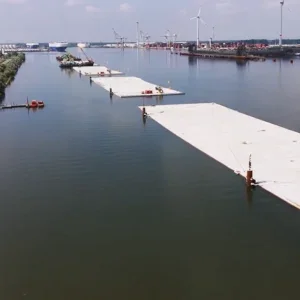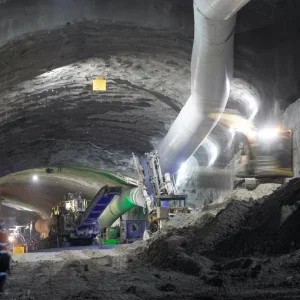Melbourne is Australia’s fastest-growing city. Its population of 4.5 million is forecast to grow to 8 million by 2051, by which time it will have outgrown Sydney to become Australia’s largest city. Like any big city, it needs a transport infrastructure. Its existing rail network is already at capacity; lines run in to the central business district (known as the CBD) and the City Loop that connects the central stations is at maximum capacity. The city’s response has been the US$7.7bn Melbourne Metro project.
Nine kilometres of twin-bore tunnel underneath the CBD, the university and the Yarra River will connect the Sunbury and Cranbourne/Pakenham railway routes. It will free-up capacity on other rail lines to enable more than a half a million additional passengers per week across Melbourne’s train network during peak periods. There will be five new underground stations, to be named Arden, Parkville, State Library, Town Hall and Anzac, and connections to the existing Flinders Street and Melbourne Central stations. Wider network improvements, for example stabling and signalling upgrades, will bring the first roll-out of high capacity signalling on an existing network in Australia.
Tunnelling began in September 2019. Four TBMs – named Millie, Meg, Alice and Joan – have been at work and more than 50% of the route has so far been tunnelled.
Paul Thomas is deputy director, tunnels and stations for Rail Projects Victoria, which is delivering the project for the Victorian Government. After managing metro projects in India and Singapore, he has been with the Melbourne project since almost the beginning. This, he says, gave great advantages. The project was unusual in that it was the client, not the contractor, who did some of the preparatory work – including some of the early construction works, such as utility diversions and critical shaft design and construction. “It was very important to me that we were actively involved during the development of the reference design and subsequent design developments,” he said. “We and our technical advisors invested a lot of time and energy into understanding the geological conditions and the hydrogeological conditions pre-tender; more importantly, we developed various methods and construction sequences in response to the anticipated ground conditions.
“This was very critical in terms of being an informed client, but it also meant that we were able to sit there on the client side and talk to our bidders during the bid process and get into technical details and key risks, explain why our assumptions are based on a certain construction method and why we were thinking that way; so a lot of knowledge got shared which was to be very, very important.
“We quite consciously embarked on a strategy of undertaking early works ourselves. We had fixed tunnel alignments; obviously the portals at each end had to tie in with existing rail structures, and there were infrastructures such as the existing CityLink road tunnels, the existing City Loop rail tunnels, the Burnley road tunnel and of course the Yarra River that obviously required us to go at sufficiently deep elevations beneath them. We did a great deal of advance monitoring of historic and significant buildings – we have placed more than 12,000 monitoring devices in all, most of which we can access remotely in real time, and these have served us throughout the project to check on settlement and such things. I can pick a settlement point on a rail track or a building and check it there and then.
“But we also wanted to understand the effects, for example, of groundwater along the alignment. Did we have drained or undrained structures in the temporary sense, what the parameters of those would be: would we have to deal with 300m3 a day of water inflows during construction, or much more, or much less? It turned out the groundwater under Melbourne is very saline – we were getting figures of 5,000mg/ lit to 14,000mg/lit, and that had implications for later disposal during construction; close coordination with one of the project’s key stakeholders, Melbourne Water, ensured an appropriate groundwater strategy was implemented.”
It was not only advance monitoring that Rail Projects Victoria (RPV) carried out. It embarked on a major programme of early works that included utility diversions, demolition works, TBM substations, existing road network upgrades and early shafts for the mined cavern stations.
“We thought, ‘Let us see where the critical path is, what the risks are’, so by fixing station box locations and tunnel alignments, that let us do quite a lot of things in advance,” Paul says.
“A very important part of the works was in the new CBD stations, where we had nine caverns in all. We decided that as part of the early works we would dig two shafts at State Library Station before the main contracts were awarded.
“That meant when we handed over to the main works delivery contractor it ensured the earliest-possible start on the mined cavern station, while the shafts also included various key operational plant and equipment rooms critical to achieving a timely testing and commissioning programme.
“We consulted with all three bidders during the procurement phase so that whatever we constructed and put in place during the early works responded as best as possible to all three solutions that the bidders would bring forward, so we could mostly cater for all potential solutions, including the special requirements for the critical plant and equipment rooms.”
In July 2017, they reached preferred contractor stage; the contract went to CYP, the Cross Yarra Partnership consortium, of Lendlease Melbourne Metro, John Holland, Bouygues Construction, John Laing and Capella Capital. CYP is responsible for the main tunnelling works, the five underground stations, station fit-out, mechanical and electrical systems and specific maintenance services for the infrastructure delivered by the package, as well as commercial opportunities at the new stations.
“The good thing was that the work we had done on reference design significantly informed CYP of what they were going to design and what they were going to deliver. Instead of re-inventing the wheel, CYP took on board elements of the reference design work and developed programme strategies into their detailed design and delivery approach.”
That approach included four TBMs, from Herrenknecht, of standard metro size, 7.28m in diameter, fitting 300mmthick lining segments, single gasket in a six-segment arrangement. The segments were locally produced at Deer Park, around 25km north-west of Melbourne, on a carousel system with steel-fibre reinforcement as well as polypropylene fibres for fire resistance. More than 57,000 individual segments are needed which are delivered by road to the sites then to the TBMs by MSV.
The TBMs were assembled in the station boxes at the new Arden and Anzac stations, the easternmost and westernmost of the new stations, and initially excavated outwards, away from the city centre, to emerge at Kensington and South Yarra respectively, where the route joins existing rail lines. The TBMs were then retrieved and dismantled and taken back to their starting points for relaunch towards the CBD. Throughout TBM operations, Arden and Anzac stations continue to be the support areas for the TBMs, including the location of the two slurry treatment plants.
The predominant geology is known as the Melbourne Formation, which makes up around 80% of the alignment. “The Melbourne geology is always interesting” said Thomas. “It is basically a siltstone sandstone, but there are distinct sub-units, which we call MF1, 2, 3 and 4. The more weathered material is MF4 and MF3, near the surface; the MF1 and 2 units are deeper and less weathered.
The TBM tunnels at some point will encounter all the differing units but this does not present any issues in terms of tunnelling.
“We did get some soft clayey silt along the alignment, which did result in some separation issues at the slurry treatment plants, one of which includes a filter press; but there has been nothing that has caused us significant concern so far.
“One of the key features of the Melbourne formation is that we get dyke features running through it. These can be quite permeable weathered intrusions so understanding where they lie can be critical, and the CBD area (where the State Library and Town Hall stations are located) contained several; but they were dealt with well. CYP adopts a very detailed and comprehensive peer review on a daily and weekly basis for all tunnelling operations, which covers encountered ground conditions, what lies ahead and how the ground is behaving. The participation of tunnel engineers, superintendents, managers, geologists, designers and ourselves has been pivotal to the continued milestones that are being achieved.
“Looking ahead, under the Yarra River we are expecting varying mixed-face conditions and a number of interfaces between the softer and harder units. In the final tunnel reaches of about 550m, we are expecting to encounter at least five different interfaces.”
Cavern Design
The station caverns have an unusual ‘trinocular’ design: three tunnels come together in parallel to form a single chamber, with a triple-cylindrical arched roof – the combined face area is approximately 390m2. “With the caverns, the important thing was that we are in the fairly competent rock material of the Melbourne Formation. The caverns are drained during construction excavation, but we don’t have to worry too much about groundwater settlement; we have little or no soft or compressible material at the surface.”
The mined excavations of the caverns use roadheaders, with a carefully-controlled incremental advance at each face. Temporary shotcrete with rock bolts is used as the primary support, and lattice girders are also used in areas.
There is a complex sequence of concurrent excavation works and permanent lining works that takes place during the development of the caverns, wherein the load distribution mechanism relies on a certain amount of permanent invert slabs and station columns being completed before the outside platform tunnels can be excavated.
The State Library cavern station is an interchange station with the existing Melbourne Central Station. The tunnels linking the State Library and Town Hall Stations are constructed beneath the existing City Loop rail tunnels, within 1m.
Tunnel stubs were constructed below the tunnels, adopting a canopy-tube roof below and partially beyond the existing tunnels. Extensive analysis was conducted over many months as the designs were developed, and prior to the mining of the stub tunnels; there was minimal disruptions to train operations and observed settlements were negligible.
More than 600,000m3 of excavated material will be removed during tunnelling works. Spoil removal has not been difficult, said Thomas. The TBMs are mixshield and use a recirculating slurry circuit as the conveyance system for the excavated material. The circuit connects the TBM to a slurry treatment plant above ground.
“Arden station, the new station at the western end of the alignment, is an old industrial area so we have quite a bit of space there and enough room for a slurry plant and other laydown areas; that means we can hold a few days’ worth of tunnelling production material there and we can treat the spoil if necessary. Similarly, at the eastern end, we have an area with two to three days of stockpile ability, with a similar slurry treatment plant – both are from Herrenknecht. And we have spoil disposal grounds which are 25km outside the central business district with good freeway connections so we haven’t really faced any significant problems in terms of spoil logistics. The spoil is trucked there, by covered trucks. That has to comply with environmental and safety requirements: the trucks have sealed bodies so no liquids can escape; all the trucks are tracked; the safety requirements are very strict.
“Our production rates are averaging 90-100m a week, which we are happy with. Having said that, our TBM alignment is mostly within the Melbourne region where generally the rock strength is around 40-60MPa, but we do get some spots where it can be harder than 100MPa. Even so, that has not caused us any particular issues of significant cutter or tool wear.
“The alignment goes through the heart of Melbourne and the CBD, but it is also adjacent to educational establishments such as the University of Melbourne and some key hospital facilities. For example, there is a very important cancer treatment centre where they have very sensitive equipment. A key thing for them is vibration and noise – what they were going to hear, and was vibration going to affect their equipment. So there’s been an incredible effort and stakeholder engagement between ourselves, our contractors and the stakeholders to make sure that disruption everywhere is minimised as much as possible. I’m happy to say hospital operations continued safely while our TBMs completed this section of tunnel.
“We will have 12 breakthroughs in total for our four machines; we have eight relaunches of the TBMs. Turnaround takes two to three months each time. The station boxes are used to service the TBMs, so part of the programme logistics is the critical interface between building the station boxes and those same station boxes being used to support a host of tunnelling operations.”
The TBMs were launched between September 2019 and May 2020. TBMs Joan and Meg have now both finished digging between the tunnel’s western entrance in Kensington and the site of the new Parkville Station, with Meg breaking through at Parkville in September 2020. They are being moved through the station site before being cleaned and recommissioned; TBM Joan was relaunched in mid-October to dig towards the new State Library Station, with TBM Meg soon to follow.
Also in September, the third TBM Millie, completed tunnelling between the new Anzac Station site and the eastern tunnel entrance in South Yarra. TBM Millie’s cutterhead and shield will be lifted out of the South Yarra tunnel entrance site by crane then transported to the Anzac Station site. The rest of the TBM will be pulled back through the tunnel to Anzac Station, then reassembled and relaunched towards Town Hall Station later this year. The fourth TBM, Alice, broke through on her parallel route in early October.
At the time of writing, (October 2020) the tunnels are around halfway to completion. More than 364,000m3 have been excavated and more than 30,000 segments have been installed. The project was originally expected to be completed in 2026 but the date has now been revised to late 2025. Progress is clearly more than satisfactory.







